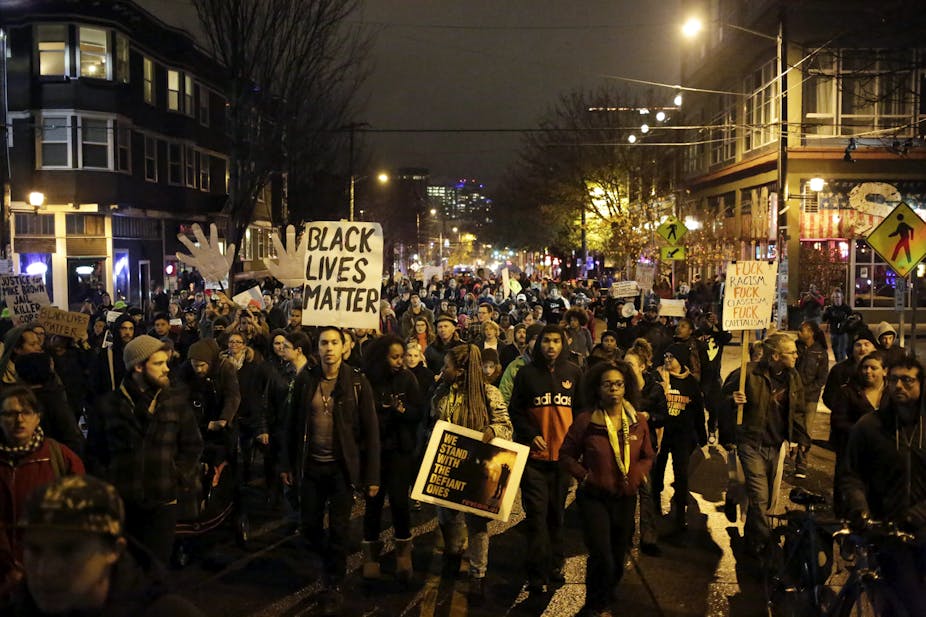Last week on ABC’s This Week, President Obama said, “My own experience tells me race relations continue to improve,” and “There’s no way to say race relations are worse than 20, 50 years ago.”
It’s impossible to ignore this assessment spoken by the leader of the free world, who just happens to identify as African American. It’s an attention grabber, especially because his assessment came just days in advance of a grand jury decision to not indict a white police officer who shot and killed Michael Brown, an unarmed black teenager, in Ferguson, Missouri.
Anxiety has been sky high there since the shooting three months ago and civil unrest shows the depth of pain and misunderstanding, and police action shows the depth of fear.
The nation’s attention is now focused on the St. Louis suburb and its handling of the situation. It should come as no surprise that some may not see as much improvement in race relations as does President Obama. There were violent protests in Ferguson after the grand jury’s verdict: a dozen buildings were badly damaged; cars were set on fire; 29 people were arrested. In fact, many blacks disagree completely with Obama’s assessment. As do some whites. How could this be true?
A legacy of disparities
A serious read of history demonstrates that black lives have been treated as less valuable than white lives, and that well-meaning whites have, on the whole, failed to appreciate the origins of racial-ethnic disparities in health, wealth, education, and incarceration – or to see them as a problem. Many believe in justice, but feel perfectly comfortable when and where racial-ethnic inequality is the norm.
Unfortunately, belief in justice does not necessarily engender frustration with the status quo or empathy for the marginalized. Regardless, the present moment presents an opportunity to address three social facts that guarantee it won’t be long before the nation’s attention focuses on another divided community or telling videotape/audiotape or insensitive Tweet or heart-wrenching statistic or incredible news story that yet again reveals the permanence of racism.
Numbers never lie
The first social fact, to paraphrase the ESPN show, is that numbers never lie. The black-white disparity in infant mortality has grown since 1950. Whereas 72.9% of whites are homeowners, only 43.5% of blacks are. Blacks constitute nearly 1 million of the total 2.3 million people incarcerated. According to Pew, white median household wealth is $91,405; black median household wealth is $6,446 – the gap has tripled over the past 25 years.
Since 2007, the black median income has declined 15.8%. In contrast, Hispanics’ median income declined 11.8%, Asians’ 7.7% and whites’ 6.3%.
Rather than focusing on race relations – or the degree to which individuals of different races appear to be civil and friendly toward each other, and to a lesser extent, the degree to which black and white lives remain segregated – it seems more sensible to talk about parity. On that score, there is evidence of an unfinished civil rights agenda.
Institutional inequality
The second social fact is that improvement in race relations is not about asking apologetically: “can’t we all just get along?” There are powerful structural forces that organize our nation and its institutions such that white lives are considered more valuable than black lives. There is institutional inequality that happens without the ill-will of any one individual. The question becomes a matter of apportioning the race problem to past inequality (that we prefer to forget) versus the contemporary actions of schools, real estate agents, hospitals, banks, elected officials, corporations, the prison industrial complex, etc. whose rules of operation seem to further entrench existing disparities. Consider, for example, the police. The shooting of unarmed men (mostly black) by allegedly well-trained policemen (mostly white) has become a depressingly frequent occurrence. Indeed, in an October 2014 study, the investigative journalism organization, Pro Publica, discovered that “young black males in recent years were at a far greater risk of being shot dead by police than their white counterparts – 21 times greater.”
Required listening
The third social fact is that tear gas should not be the preferred response to tears of frustration, angst, and disappointment shed by blacks and other marginalized groups.
In situations like Ferguson, people on both sides of the issue need to reflect carefully on and express openly their divergent views of why Brown was shot. Repression of either side of the story is counter-productive. But truly hearing both sides of the story requires empathy. Racism thrives in part because whites suffer from what I would call social alexithymia – they literally cannot imagine the lives of blacks and the burdens of social dislocations and criticism heaped upon the black community. The mere mention of racism or racial inequality, it seems, causes many whites to go deaf – whereas civil unrest seems to restore their hearing.
The symbolism of Ferguson
Ferguson is not a special case. It’s just evidence that race cleaves our nation, tensions simmer just below the surface, and far too many people who believe in justice are comfortable watching its miscarriage.
That does not mean that the white officer who shot Brown dead should have been indicted – apparently the evidence did not support such. But it does mean that everyone should be outraged because blacks are not yet full citizens of this nation. We need indignation. We need to take a stand.
Otherwise we are, in effect, accepting the permanence of racism: no longer the white-sheet-wearing KKK member, Archie Bunker type, but instead the type that allows polite neglect of racial and socioeconomic inequality, and permits sanguine assessments of progress discordant with the experiences of everyday people who feel abandoned and invisible and worthless.

